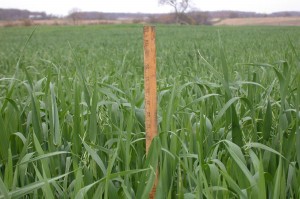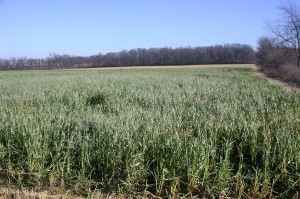Pasture growth has been tremendous so far this year, but late summer heat and dry spells can change conditions quickly.
Now is the time to consider opportunities for planting supplemental forage “cover crops” for grazing or hay/haylage production later this fall.
Summer planting
Supplemental forage options for late summer planting include summer annual grasses, small grains, and annual/Italian ryegrass on land coming out of wheat or corn silage.
Summer annual grasses such as sudangrass, sorghum x sudangrass hybrids, or pearl millet should be planted as soon as possible after wheat grain harvest. By the time this article comes out, it will be about too late for that option.
Small grains and annual/Italian ryegrasses should be planted beginning in early August, so that is what we will focus on in this article.
Caution
Before making any planting plans, be sure to check the plant back restriction interval for herbicides used in the previous crop. Corn herbicides, especially atrazine products, have a long rotation restriction interval for many of the forage options listed below.
Early August plantings
Spring oat, spring triticale, or annual/Italian ryegrasses are excellent options for early August plantings.
Oat seed usually can be purchased at a more economical price than spring triticale seed, but either species will produce good dry matter yields within 60 to 80 days after planting.
When planted the first two weeks of August and assuming adequate rainfall, oat and spring triticale can produce 4,000- to 5,000 lbs/acre of dry matter by mid-October when they will be in the boot stage. If harvest or grazing is delayed until November, they will be in heading stage with yields of 6,000 pounds of dry matter/acre or more.
Protein and fiber

Early August planted oats or spring triticale forage will have crude protein (CP) content of 12 to 15 percent and neutral detergent fiber (NDF) of 38 to 50 percent depending on planting date and stage at harvest.
When planting in early August, field peas or soybeans could be added to small grains to boost the CP content of the forage, an important consideration for dairy producers.
We would expect the CP content to be increased by 3 to 4 percentage units when including field peas or soybeans with oats or spring triticale planted by mid-August. This should provide an extra value of $40 to $50/acre from the increased protein content of the forage.

Legume seed cost
This needs to be compared to the extra cost of the legume seed included in the mixture. If the legume seed cost is no more than $50/acre, then including the legume in the mixture should be cost effective for lactating dairy cows, because the legume-small grain mixture should have lower NDF content leading to higher forage intake and greater milk production.
Field peas should be inoculated with N-fixing bacteria and sown in the mixture at 70 to 90 lb/acre. Soybean seeding rates for this application are not well-defined, but perhaps should be included in the mixture at 60 to 70 percent of normal soybean seeding rates.
Ryegrass
Annual or Italian ryegrass can also produce high quality forage in the autumn when planted in August. They can be grazed in late autumn and early winter followed by forage harvests or grazing next year.
Some varieties have better winter survival than others, so check variety performance in your region. University annual/Italian ryegrass variety trials are available in a several states, including Ohio, Kentucky, Pennsylvania, New York, and Wisconsin.
The forage quality of annual or Italian ryegrass will be at least equal to and is usually higher than that of the small grain forages discussed above.
Later plantings
Spring oat, spring triticale, and annual/Italian ryegrasses can also be planted from late August to mid-September, such as immediately after an early corn silage harvest.
These later planting dates will produce lower yields than earlier plantings, ranging from 1,500 to 3,000 pounds dry matter/acre.
Later planting means that harvest will be delayed into months with poor drying conditions (November to early December). Grazing or green chopping is a better way to utilize later planted forages than trying to make silage or haylage.
Forage quality in autumn will be very high when planting these annual forages in early September. Crude protein will range from 20 to 32 percent, NDF will be 30 to 38 percent, and NDF digestibility will be 75 to 85 percent in the forage in late autumn.
If an early spring forage harvest is desirable next year, Italian ryegrass should be used or mixtures of winter triticale and/or winter rye included with spring oat or spring triticale.
Ohio experience
We have planted annual/Italian ryegrass in early September for several years in central Ohio. We usually harvest 800 to 2,000 pounds of dry matter/acre by early December with 45 pounds nitrogen added per acre.
The following year, yields range from 3 to 7 tons of dry matter/acre with adequate nitrogen fertilization. The higher yields occur under good rainfall conditions.
Late September plantings
Wheat, winter triticale, and winter rye can be planted by early October to produce good yields of high quality forage the following spring.
Wheat planting should be delayed until after the Hessian fly-safe date, which is Sept. 22 in northern Ohio and Oct. 5 in southern Ohio.
Rye will grow and mature the quickest in the spring and has the deserved reputation of becoming “like straw” in a short period of time in the spring.
Wheat and winter triticale will be easier to manage next spring because they mature later and more slowly than rye.
Forage quality is excellent for these species if harvested in the vegetative to boot stage of growth in the spring, with yields of 2 to 4 tons/acre of dry matter depending on harvest stage.
Seeding rates
Plant high quality seed of a known variety, which will ensure high germination rate and avoid unpleasant surprises regarding varietal identity and crop characteristics.
Oat should be planted at 75 to 100 pounds per acre and spring triticale at 90 to 110 lbs/acre when seeded alone.
Winter rye should be seeded at 110 lbs/acre while wheat and winter triticale should be seeded at 110 to 120 lbs/acre.
For mixtures of these small grains, the seeding rate of each component can be reduced to 70 percent of the full rate.
Annual/Italian ryegrass should be planted at 20 to 25 lbs/acre, with 30 to 50 pounds of nitrogen per acre added either at planting or in the early tillering stage.
Additional nitrogen will be required next spring for good production, usually 50 pounds of actual nitrogen per acre in early spring and again after the first or second harvest.
Agronomic management
No-till planting in late summer will conserve moisture and provide firmer soil conditions for either harvesting equipment or grazing animals later this fall. A burn-down application of glyphosate is an important and cost-effective weed control practice prior to planting.
When planted after wheat grain harvest, oat, spring triticale, or annual ryegrass will likely require 40 to 50 pounds of nitrogen per acre at planting.
Manure applications can replace some or all of the N fertilizer need, depending on the amount of readily available N in the manure.
When planting small grains or annual/Italian ryegrass after corn silage, be aware of the potential for nitrogen carryover from the corn. Depending on the rate of nitrogen applied to the corn silage, it may NOT be advisable to apply additional nitrogen to these annual grasses.
Excessive nitrogen carryover from corn coupled with additional nitrogen fertilizer applied to the new plantings can result in toxic levels of nitrates in the forage produced this fall.
Harvesting options
Chopping and ensiling are the best mechanical harvest alternatives for these supplemental forages, whether harvesting this fall and or next spring.
Wet wrapping individual bales will work, but is more expensive than ensiling into a permanent structure or long silage bags.
Dry baling in the autumn is a challenge because the small grains dry about half as fast as grass hay. Ryegrasses are also slower to cure than other grasses.
For September planted forage, grazing will provide the most effective and affordable alternative for utilizing the forage. Ohio beef cattle producers have strip grazed oats all winter long, so grazing through part of the winter should be an option for dry cows or heifers. Oats won’t die until temperatures have been in the mid-20s for several hours. That means they’ll still be green and alive in December most years in Ohio.
Winter rye, winter triticale, wheat, and Italian ryegrass will survive even longer before going dormant.
Protection AND feed
Producers and researchers alike are learning more and more of the value of cover crops in grain production systems. As you can see from the discussion above, “cover crops” planted after wheat grain and corn silage harvests provide excellent opportunities to produce and utilize supplemental forage for ruminant livestock.
Besides being an economical option to produce more forage, the “cover crop” options discussed here will increase the efficiency of land use and help protect the soil, which would otherwise sit idle and bare until next spring.
Think about it…then go plant!
(Fairfield County OSU Extension Program Assistant Stan Smith contributed to this article.)











